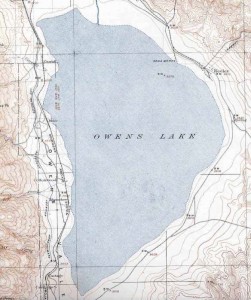

This post was written by Ben Hand, 2012 Mono Lake Intern.
On August 1, the Mono Lake Committee was treated to a rich and erudite presentation on the future of the Owens Lake—the first in our annual series of speakers titled “Refreshments with Refreshing ‘Ologists.”
Those familiar with the history of Mono Lake will know that before the Los Angeles Department of Water & Power (DWP) extended their aqueduct to the Mono Basin, their main source of water was Owens Lake; located 60 miles south of the Mono Basin along Highway 395. But between 1913 and the early 1930s Owens Lake was drained with such abandon that by the mid-1930s all that remained was miles of dry lake floor and a rough coastal skeleton of the former lake. Having extinguished Owens Lake, DWP began work on extending their aqueduct to the Mono Basin, a project which was completed in 1941. The rest, as they say, is history.
But the story of Owens Lake has not completely run its course. Peter Pumphrey, our guest speaker on the 1st, and President of Eastern Sierra Audubon, explained to us the idea behind “The Owens Lake Master Plan.” As a result of having been drained by DWP in the 1930s, the area in and around the former lakebed in the Owens Valley has consistently experienced some of the worst air quality, in terms of dust particulates, in the United States; this includes the constant threat of vicious dust storms that originate on the former lake bed and endanger the health of both animals and residents of the Owens Valley. As a result of this continuous threat to the health of local life, DWP has been forced to address the vexing problem of dust in the Owens Valley.
As Mr. Pumphrey explained in his presentation, DWP had three main options available to combat dust storms on the lake bed: planting salt-grass, laying gravel, or watering problematic areas of the lake bed. They began with what seemed to be the most obvious solution—utilizing the thousands of acre-feet of water that pass by the Owens Valley as they make their way through the aqueduct from the Mono Basin to Los Angeles. Using an extensive piping infrastructure, DWP has created a series of pools and flooded plains, varying in depth from only a few inches to several feet, which now stretch across the former lake bed. These pools are filled using water from the Mono Basin, and it is hard to miss the irony that a vast majority of the water that DWP removes from the Mono Basin is now making it no further down the aqueduct than the Owens Valley.
The Owens Lake Master Plan, which Mr. Pumphrey is helping to shape, is an attempt to create a plan of action for how to move DWP’s dust containment plan into a sustainable long-term solution. The current amount of water being used to flood portions of the lakebed—reportedly close to 16,000 acre-feet, according to Mr. Pumphrey—is far too much to be an acceptable long-term solution; and so the Owens Lake Master Plan is an attempt to maximize the effectiveness of water allocation across the dried lake bed.
The main variable in considering how water can be used most effectively, besides dust control, is the affect that water allocation will have on the many birds that now call the Owens Valley home for part or all of the year. Birds—in vast and unprecedented numbers—began to arrive in the Owens Valley as small ponds and flooded fields were created by DWP’s efforts to mediate the dangerous dust conditions in the area. The population of migratory birds in the Owens Valley has become so rich and voluminous that the former Owens Lake has become one of the premier birding locations in the Eastern Sierra. Thus, any long-term plan for Owens Lake and the Owens Valley must think critically about how to manage a multitude of important variables: cost-effectiveness, water conservation, dust levels, aesthetic impact, and bird habitats. Fortunately, it appears that by relying on the knowledge of experts and community members like Mr. Pumphrey, a plan is being developed that aims to use a quantifiable measure of quality habit creation; and then utilize that measure to make decisions about water allocation and costs.
Mr. Pumphrey’s talk was a wonderful opportunity to learn about the ongoing events in the Owens Valley, and set an exciting precedent for what will hopefully be a series of exciting Wednesday talks. Please join us for our next installment at 4:00pm on Wednesday, August 22 for a talk by Connie Millar.
